Turquoise has long been associated with the American Southwest and Native American jewelry. The ancient tradition of making beads and small carved ornaments by our native people has evolved over time as new sources of gemstones and shells have become available. With access to many of the gemstones from around the world, contemporary southwest and Native American artisans create colorful works of art. Many of these gemstones have attained a note-worthy place in the southwest native fine-art jewelry world.
ABALONE
Abalone is a mollusk shell that has been used for personal and ceremonial adornment since early times. Abalone has been considered sacred by many Native Americans and has been used by medicine men. Native Americans from the Plains, Plateau and California have used abalone in necklace stringing and was used in the first inlay work in the Southwest.
Abalone is found in the coastal waters off of the US and Mexico. Since the late 1990's, due to over harvesting and polluted waters, abalone has become nearly extinct. This can still be seen today in earlier Zuni inlay jewelry and in limited amounts of contemporary jewelry.
AMBER
Amber is an organic gem formed from the hardened, fossilized sap or resin of pine trees. It is a beautiful gem that is cut and polished and used as a valuable gemstone. Amber can contain insects and plants that are millions of years old such as gnats, flies, wasps, bees, ants and mosquitoes. Sometimes there may even be moths, beetles or grasshoppers. Amber varies from yellow and orange and brown. It is usually found in the Baltic countries and in coal seams in Wyoming and the Dominican Republic.
AMETHYST
Amethyst, a transparent purple variety of quartz, is one of the best known and most valuable form of quartz. The name "amethyst" comes from the Greek and means "not drunken." It was once thought to prevent the wearer from getting drunk and also thought to bring peace of mind.
Amethyst is purple and ranges from light to dark which is caused by iron or manganese compound impurities in the mineral. Amethyst comes from many parts of the world and each locality can produce a unique amethyst to that area or particular mine. Some of the finest comes from Brazil, Bolivia, and Russia. It can also be found in Australia, Canada, Germany, Uraguay, Madagascar, Namibia, Sri Lanka, Zambia, Mexico, Italy and the United States. Amethyst can fade from heat and exposure to the sun - protect your amethyst from these conditions.
AMMONITE

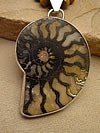 Ammonites are the fossilized, hard shells of extinct mollusks that existed from the Paleozoic to the end of the Cretaceous era. They were abundant in all the oceans. Their closest relative is the chambered Nautilus from the Pacific and Indian oceans. After millions of years the original shell is slowly replaced by minerals such as agate or calcite. Ammonite fossils are found on every continent. They are treasured for their appearance and form. Some show very intricate suture patterns, which are created by the complex walls dividing the inside of the shell.
Ammonites are the fossilized, hard shells of extinct mollusks that existed from the Paleozoic to the end of the Cretaceous era. They were abundant in all the oceans. Their closest relative is the chambered Nautilus from the Pacific and Indian oceans. After millions of years the original shell is slowly replaced by minerals such as agate or calcite. Ammonite fossils are found on every continent. They are treasured for their appearance and form. Some show very intricate suture patterns, which are created by the complex walls dividing the inside of the shell.
The Navajos and other Native American Indian tribes carried ammonites in their medicine bags for health and good hunting. They were called Buffalo stones because of their resemblance to the North American Bison.
AZURITE
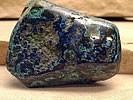
Azurite is a copper ore and occurs in a vivid blue. Azurite and malachite can fuse together – they have a similar formulae. Never clean malachite or azurite with any product containing ammonia.
CHAROLITE - CHAROITE
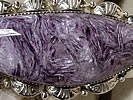 Charoite is a relatively late comer to the Native American jewelry marketplace, having been known only since the mid 1970’s. The color of charoite is described as a stunning lavender, lilac, violet or purple. The white chrystalline "needles” give charoite a very distinctive appearance and depth often forming a swirling pattern of interlocking chrystals. Charoite is found in the inerfluve of the Chara and Tokkin rivers, northwest of Aldan on the Jakutsk area, northeast of Lake Baikal, Russia.
Charoite is a relatively late comer to the Native American jewelry marketplace, having been known only since the mid 1970’s. The color of charoite is described as a stunning lavender, lilac, violet or purple. The white chrystalline "needles” give charoite a very distinctive appearance and depth often forming a swirling pattern of interlocking chrystals. Charoite is found in the inerfluve of the Chara and Tokkin rivers, northwest of Aldan on the Jakutsk area, northeast of Lake Baikal, Russia.
CHRYSOPRASE
Chrysoprase is a highly translucent, bright, light green to dark green valuable form of chalcedony. The stone’s vivid green color comes from nickel silicate. It is usually cut into cabachons. This stone is mined exclusively in Australia and is sometimes confused with jade and called "Australian jade”.
CORAL
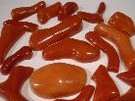 Coral is one of the world's few organic gems. The oldest known findings of red coral date from the Mesopotamian civilization from about 3000 B.C. Coral is formed from a colony of marine invertebrates that is primarily a skeletal calcium carbonate gem. The formations as seen in the water look like tree branches. Many colors and varieties of coral are found in warm coastal waters from around the world. Coral varies in color: white, pink, orange, red and black. The rarest variety is the blood coral or oxblood coral. This is a very deep red variety. The best oxblood coral comes from the Mediterranean Sea. C Because of its calcium composition coral should not come in contact with acid such as vinegar. Coral is usually cabochon cut. Coral is often inlaid with jet, mother of pearl and turquoise in Zuni jewelry and set in cabachons with turquoise in Navajo jewelry. Set in turquoise jewelry this is often viewed as traditional gems of Native American jewelry.
Coral is one of the world's few organic gems. The oldest known findings of red coral date from the Mesopotamian civilization from about 3000 B.C. Coral is formed from a colony of marine invertebrates that is primarily a skeletal calcium carbonate gem. The formations as seen in the water look like tree branches. Many colors and varieties of coral are found in warm coastal waters from around the world. Coral varies in color: white, pink, orange, red and black. The rarest variety is the blood coral or oxblood coral. This is a very deep red variety. The best oxblood coral comes from the Mediterranean Sea. C Because of its calcium composition coral should not come in contact with acid such as vinegar. Coral is usually cabochon cut. Coral is often inlaid with jet, mother of pearl and turquoise in Zuni jewelry and set in cabachons with turquoise in Navajo jewelry. Set in turquoise jewelry this is often viewed as traditional gems of Native American jewelry.
FOSSILIZED IVORY
Fossilized ivory or ancient ivory comes from walrus ivory or prehistoric mammoth or mastodon tusk. The ivory has not yet fossilized into stone but is in the first stages of mineralization. Fossilized or mineralized walrus tusk is approx. 500 to 3,000 years old and most of which is excavated along the Bering Sea coast of Alaska by Eskimo families. Mammoth and mastodon ivory are approx. 10,000 to 40,000 years old. The ivory varies in color from the age and minerals of the soil: tans, orange-browns to dark browns. Most of the Zuni fetish carvings seen are carved from fossilized walrus ivory.
GASPEITE
Gaspeite was discovered in 1966 in the Lemieux Township of the Gaspe' Peninsula, Quebec, Canada. It is also found in western Australia - the best from North of Perth, Australia. It is found as a secondary mineral around nickel sulfide deposits. Gaspeite comes in light green to an unmistakable apple green color. Gaspiete is usually cut in cabachons.
Gaspeite is often set in cabacons in Navajo jewelry. Gaspeite is also inlaid with other gems in contemporary inlay producing vibrant and colorful Native American jewelry.
JET
Jet is Anthracite Coal which is a sedimentary rock formed from plants that lived millions of years ago. The most well known source of jet is along the eastern coast of Yorkshire, England and there are large deposits in Utah. Jet is used a great deal in contemporary and traditional Native American inlay jewelry.
LAPIS LAZULI
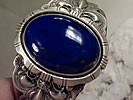 Lapis has been highly prized since ancient Babylonian and Egyptian times. Genuine lapis is a natural blue, opaque stone. It is brilliant deep blue and sometimes possesses small sparkling gold or silver colored flecks which are pyrite inclusions. The best lapis comes from Afghanistan and Argentina. It can also be found in Russia, Chile, Canada and occasionally the U.S.
Lapis has been highly prized since ancient Babylonian and Egyptian times. Genuine lapis is a natural blue, opaque stone. It is brilliant deep blue and sometimes possesses small sparkling gold or silver colored flecks which are pyrite inclusions. The best lapis comes from Afghanistan and Argentina. It can also be found in Russia, Chile, Canada and occasionally the U.S.
MALACHITE
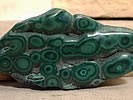 Malachite is named for the Greek work "mallow" which is a green herb. Malachite is a copper ore that comes in a brilliant green marked with bands of contrasting shades of the same green. Malachite is often found in copper producing areas such as Russia, Mexico, Australia, England, Southwest U.S. and notably Zaire is a major producer today. Never clean malachite with any product containing ammonia.
Malachite is named for the Greek work "mallow" which is a green herb. Malachite is a copper ore that comes in a brilliant green marked with bands of contrasting shades of the same green. Malachite is often found in copper producing areas such as Russia, Mexico, Australia, England, Southwest U.S. and notably Zaire is a major producer today. Never clean malachite with any product containing ammonia.
MOTHER OF PEARL
Mother of Pearl is a hard, iridescent inner layer of certain shells such as abalone, pearl oyster and mussel. Mother of pearl varies in shades of white, yellow, pink and gray. Care should be taken not to expose it to chemicals.
Mother of pearl is often inlaid with turquoise, jet and coral in Zuni jewelry and contemporary inlay Navajo jewelry.
SPINY OYSTER SHELL

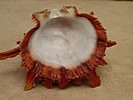 Spiny Oyster Shell, Spondylus Brodnip Princess, is found in the Sea of Cortez, Baja California, Mexico. Spiny Oyster began to be exported for jewelry making in the Southwest in 1976. The shell comes in three main colors: red, orange, purple and sometimes white and yellow.
Spiny Oyster Shell, Spondylus Brodnip Princess, is found in the Sea of Cortez, Baja California, Mexico. Spiny Oyster began to be exported for jewelry making in the Southwest in 1976. The shell comes in three main colors: red, orange, purple and sometimes white and yellow.
The name Spondylus is a Latin word that means "spines on its back." Brodnip was the name of the scientist who traveled with Cortez when Baja California was explored. The name "princess" was given to the shell when Cortez presented his marine discoveries to the King of Spain. The king's daughter fell in love with the shell; thus, it was named after her.
Spiny oyster shell is set in cabachons in Navajo jewelry and is often inlaid with other gems in contemporary and colorful Navajo inlay jewelry.
Shop Spiny Oyster Shell Jewelry
SUGILITE
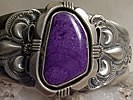 Sugilite is named for the Japanese petrologist who discovered it, Kenichi Sugi. Sugilite is found only in South Africa and is a by product of mining for manganese ore. It is found in very deep shafts about 2 miles deep. Sugilite first appeared in jewelry in the late 1970's and was sold as Royal Azel and Royal Lavulite. It is lovely, deep, rich purple to purple red in color. It is an opaque gem that is usually cut into cabachons or beads and is used in inlay work by top Native American Indian artisans.
Sugilite is named for the Japanese petrologist who discovered it, Kenichi Sugi. Sugilite is found only in South Africa and is a by product of mining for manganese ore. It is found in very deep shafts about 2 miles deep. Sugilite first appeared in jewelry in the late 1970's and was sold as Royal Azel and Royal Lavulite. It is lovely, deep, rich purple to purple red in color. It is an opaque gem that is usually cut into cabachons or beads and is used in inlay work by top Native American Indian artisans.
TURQUOISE
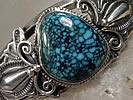 Turquoise has captivated man's imagination for centuries. The robin's egg blue gemstone, worn by Pharoahs and Aztec kings, is probably one of the oldest gemstones known. There are archaeological as well as literary references that pre-date the Christian era by five millennia. The four bracelets of Queen Zar, found on her mummified arm, date to the second ruler of Egypt's First Dynasty, approximately 5500 B.C. Scholars believe the robe worn by the High Priest Aaron was adorned with turquoise. Aristotle, Pliny and other early writers refer to stones that must have been turquoise. Turquoise jewelry is as intriguing today as ever.
Turquoise has captivated man's imagination for centuries. The robin's egg blue gemstone, worn by Pharoahs and Aztec kings, is probably one of the oldest gemstones known. There are archaeological as well as literary references that pre-date the Christian era by five millennia. The four bracelets of Queen Zar, found on her mummified arm, date to the second ruler of Egypt's First Dynasty, approximately 5500 B.C. Scholars believe the robe worn by the High Priest Aaron was adorned with turquoise. Aristotle, Pliny and other early writers refer to stones that must have been turquoise. Turquoise jewelry is as intriguing today as ever.
Turquoise has been, since 200 B.C., extensively used by both southwest American Indian tribes and by many other Indian tribes in Mexico. Archaeological evidence exists that the prehistoric people, the Anasazi and Hohokam, mined turquoise at Cerrillos and the Burro Mountains of New Mexico. Kingman and Morenci turquoise from Arizona was a popular trade item and has been found in archaeological sites hundreds of miles away from these mines. Turquoise from Cerrillos mine in New Mexico has been found with the Aztecs. The stone was used in religion, art, trade, treaty negotiations as well as jewelry. Even today, it is still considered as the stone of life, good fortune and symbol of wealth by our American Indians and other cultures of the world. This valued gem is the center piece of most Native American Indian jewelry.
Turquoise, chemically, is a hydrated phosphate of copper and aluminum and is formed by the percolation of meteoric or groundwater through aluminous rock in the presence of copper. For this reason, it is often associated with copper deposits as a secondary mineral. Turquoise is most often found in arid, semiarid or desert places such as Iran, Tibet, China, Australia, Mexico, Russia, Turkestan and the southwest U.S.
Turquoise gets its color from the heavy metals in the ground where it forms. Blue turquoise forms when there is copper present, which is the case with most Arizona turquoise. Green turquoise forms where iron is present, the case with most Nevada turquoise. Matrix is the host rock, mother rock. It can be made from several different elements such as pyrite, chert, quartz, cuperite and manganese oxide. The sought after spider web turquoise is made up of small nuggets naturally cemented together with rock or matrix. When cut and polished the stone resembles a spider web.
So many geologic chains of events must synchronize to create just one thin vein of turquoise that the mineral can rightly be envisioned as a fluke of nature. Turquoise is the rare and improbable product of an incalculable number of chemical and physical processes that must take place in the right combination and proper environment over a time span of hundreds of thousands - if not millions - of years.
Read more about Turquoise quality and grades.
American Turquoise Mines
TURQUOISE - AJAX
The Ajax mine is located in south-central Nevada in the Royston area. A relatively new mine that yields stones from light blue with darker blue veins to a predominate dark green with light blue veins. The dark green with light blue veins is considered quite unusual for turquoise.
TURQUOISE - BISBEE
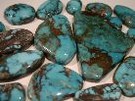 The Bisbee mine, near Bisbee, Arizona, is one of the more famous of the American mines because it was one of the first to be put on the market. Bisbee turquoise is a significant by-product of the Lavender Pit copper mine that is now closed. Bisbee turquoise is famous for its deep blue color and its smoky black matrix. Most of this turquoise has already been mined, and is one of the most highly collectible stones.
The Bisbee mine, near Bisbee, Arizona, is one of the more famous of the American mines because it was one of the first to be put on the market. Bisbee turquoise is a significant by-product of the Lavender Pit copper mine that is now closed. Bisbee turquoise is famous for its deep blue color and its smoky black matrix. Most of this turquoise has already been mined, and is one of the most highly collectible stones.
TURQUOISE - BLUE GEM TURQUOISE
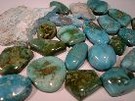 Blue Gem mine was located approximately 6 miles south of Battle Mountain, Nevada, within a large copper-mining operation. Blue Gem mine produced almost every shade of green and blue from intense blues to deep green combinations with a hard, irregularly distributed matrix. Of the several Nevada mines that are named Blue Gem, the Battle Mountain Blue Gem mine, which began production in 1934, yielded the most valuable Blue Gem turquoise because of its rich color and hardness. This mine is now closed and is highly sought after by collectors. Great addition to your turquoise jewelry collection in a good gem grade.
Blue Gem mine was located approximately 6 miles south of Battle Mountain, Nevada, within a large copper-mining operation. Blue Gem mine produced almost every shade of green and blue from intense blues to deep green combinations with a hard, irregularly distributed matrix. Of the several Nevada mines that are named Blue Gem, the Battle Mountain Blue Gem mine, which began production in 1934, yielded the most valuable Blue Gem turquoise because of its rich color and hardness. This mine is now closed and is highly sought after by collectors. Great addition to your turquoise jewelry collection in a good gem grade.
TURQUOISE - BLUE MOON TURQUOISE
Blue Moon turquoise mine was active until the late 1970's in Esmeralda County, Nevada. Most turquoise now comes from private collections. Typically, light-sky blue with a dark brown to black matrix.
TURQUOISE - CANDELARIA TURQUOISE
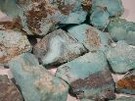 The Candelaria turquoise mine is a small Nevada mine that produces very little stone and is only occasionally worked. The turquoise is of good quality and is a high blue color with an intermittent black or brown, non-webbed matrix. Because it is not frequently available it is considered collectible. A great addition to add to your turquoise jewelry collection.
The Candelaria turquoise mine is a small Nevada mine that produces very little stone and is only occasionally worked. The turquoise is of good quality and is a high blue color with an intermittent black or brown, non-webbed matrix. Because it is not frequently available it is considered collectible. A great addition to add to your turquoise jewelry collection.
TURQUOISE - CARICO LAKE TURQUOISE
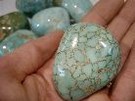
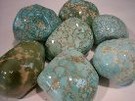 Carico Lake turquoise is named after the location of its mine on a dried up lake bed in a high, cool area of Lander County, Nevada. Carico Lake turquoise mine is located at higher elevation than most turquoise mines. It has been marketed under names such as Aurora and Stone Cabin. Its clear, iridescent, spring-green color is due to its zinc content and is highly unique and collectible. Carico Lake turquoise is also found in a dark blue-green color with a black, spider web matrix. It known for the Irish green color turquoise that is mined due to the zinc mineral. The Carico Lake mine is primarily a gold producing mine but from time to time the mining company leases the turquoise producing part of the mine to individual miners who are permitted to work that part. The limited amount of gem grade turquoise and time allowed to mine it make Carico Lake turquoise a valuable addition to one's collection.
Carico Lake turquoise is named after the location of its mine on a dried up lake bed in a high, cool area of Lander County, Nevada. Carico Lake turquoise mine is located at higher elevation than most turquoise mines. It has been marketed under names such as Aurora and Stone Cabin. Its clear, iridescent, spring-green color is due to its zinc content and is highly unique and collectible. Carico Lake turquoise is also found in a dark blue-green color with a black, spider web matrix. It known for the Irish green color turquoise that is mined due to the zinc mineral. The Carico Lake mine is primarily a gold producing mine but from time to time the mining company leases the turquoise producing part of the mine to individual miners who are permitted to work that part. The limited amount of gem grade turquoise and time allowed to mine it make Carico Lake turquoise a valuable addition to one's collection.
Mines in this district also produce faustite, an apple-green mineral similar to turquoise but identified as a separate mineral in 1953.
TURQUOISE - CERRILLOS TURQUOISE
Cerrillos turquoise mine, located between Santa Fe and Albuquerque, New Mexico, is one of the most famous prehistoric mining districts in the American Southwest. It has a history entwined with both the ancient Native people of the Southwest and more recent American mining companies.
Cerrillos turquoise was created and mined under unusual circumstances. It is the only turquoise that formed at the base of a volcano; thus, a variety of colors developed from the minerals in the various volcanic host rocks. Seventy-five colors have been identified, from tan to khaki-green to rich, blue-green to bright, light colors. Cerrillos turquoise is a very hard stone that takes a good polish. This is a valuable addition to your turquoise jewelry collection.
In addition to producing a distinctive stone, the Cerrillos turquoise mine is the oldest mine of any kind in North America. Located ten miles south of Santa Fe, Cerrillos was the site of the largest prehistoric mining activity on the continent because the huge turquoise deposit was partially exposed on the surface. Pueblo people mined the are extensively between 1300 and 1600 A.D. Pueblo miners from the San Marcos Pueblo, who later moved to the Santo Domingo Pueblo south of Santa Fe, most heavily worked the mine. Pueblo miners removed 100,000 tons of solid rock to create a pit mine 200 feet deep. An incredible feat considering they only used stone axes, mauls, antler picks and chisels. They dug other vertical shafts into the ground to reach veins of turquoise. Miners carried tools and leather rock baskets on their backs as they climbed in and out of the shafts using notched logs as ladders. The turquoise obtained here by the early Pueblo miners was traded from Mexico to the Midwest and from the east and west coasts. In New Mexico, many pieces of Cerrillos turquoise for personal use and trade have been unearthed in the prehistoric ruins of Pueblo Bonito in Chaco Canyon. The Pueblo people continued to extract turquoise from the Cerrillos mine until the 1870's when a silver mining boom raised an interest in the area. The Tiffany Company in New York and its associates bought up the mine area and extracted $2,000,000 worth of turquoise between 1892 and 1899.
There are more than two hundred dig sites located there and the largest and most famous are the Blue Bell, Castilian and Tiffany mines.
TURQUOISE - CRIPPLE CREEK TURQUOISE
Cripple Creek turquoise mine is located in Teller County, Colorado and was discovered when miners looking for gold in the area also found turquoise deposits. Two separate mines are currently active in the area both under the Cripple Creek name.
TURQUOISE - DAMELE TURQUOISE
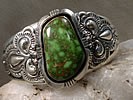 The Damele {also known as Damali} mine is located in east-central Nevada near the Carico Lake mine. Damele turquoise is quite distinctive because the zinc content turns the stone yellow-green and increases its hardness. The matrix of Damele is webbed with a dark brown to black matrix. The mine is small, thus its availability is limited. Due to its rare color, Damele is a collectible turquoise.
The Damele {also known as Damali} mine is located in east-central Nevada near the Carico Lake mine. Damele turquoise is quite distinctive because the zinc content turns the stone yellow-green and increases its hardness. The matrix of Damele is webbed with a dark brown to black matrix. The mine is small, thus its availability is limited. Due to its rare color, Damele is a collectible turquoise.
TURQUOISE - DRY CREEK TURQUOISE
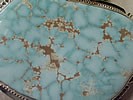 The Dry Creek turquoise mine is located on the Shoshone Indian Reservation near Battle Mountain, Nevada. Discovered in 1993, they were not sure what it was. Because of its hardness, it was decided to send it to have it assayed and it was in fact, as thought, turquoise. It was not until 1996 that it was used in jewelry. Turquoise gets its color from the heavy metals in the ground where it forms. Dry Creek turquoise forms where there are no heavy metals present, which turns out to be a very rare occurrence. The lack of any specific color consistency makes this stone distinctive and unique from other turquoises. The turquoise runs from creamy white to a soft pale blue. The matrix runs from a complimentary light yellow, gray or black color. To date, no other vein of this turquoise has been discovered anywhere else and when this current vein runs out, that will be the last of it. Because this turquoise is as rare as the sacred buffalo, the Indians call it "Sacred Buffalo" Turquoise. Dry Creek turquoise is also referred and known by the names Godber turquoise and Burnham turquoise.
The Dry Creek turquoise mine is located on the Shoshone Indian Reservation near Battle Mountain, Nevada. Discovered in 1993, they were not sure what it was. Because of its hardness, it was decided to send it to have it assayed and it was in fact, as thought, turquoise. It was not until 1996 that it was used in jewelry. Turquoise gets its color from the heavy metals in the ground where it forms. Dry Creek turquoise forms where there are no heavy metals present, which turns out to be a very rare occurrence. The lack of any specific color consistency makes this stone distinctive and unique from other turquoises. The turquoise runs from creamy white to a soft pale blue. The matrix runs from a complimentary light yellow, gray or black color. To date, no other vein of this turquoise has been discovered anywhere else and when this current vein runs out, that will be the last of it. Because this turquoise is as rare as the sacred buffalo, the Indians call it "Sacred Buffalo" Turquoise. Dry Creek turquoise is also referred and known by the names Godber turquoise and Burnham turquoise.
TURQUOISE - EASTER BLUE TURQUOISE
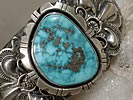 Easter Blue turquoise is mined in Nevada and is in the Royston turquoise mining area. It is one of the oldest turquoise mined in Nevada. The mine produces gem grade blue-green with a matrix. Turquoise from this mine will be a unique addition to your turquoise jewelry collection.
Easter Blue turquoise is mined in Nevada and is in the Royston turquoise mining area. It is one of the oldest turquoise mined in Nevada. The mine produces gem grade blue-green with a matrix. Turquoise from this mine will be a unique addition to your turquoise jewelry collection.
TURQUOISE - ENCHANTMENT TURQUOISE
Enchantment turquoise mine is located near the town of Ruidosa, in the Sacremento Mountains of southeastern New Mexico. A gold miner while prospecting in 1958 "rediscovered" the "Lost Mine of Enchantment." It was first identified on an 1895 map as "old Indian diggings." It is the first new mine discovered in New Mexico since the days of Coronado in the 1500's. The mine remained a well-kept secret until 1997 when the miner visited the Turquoise Museum in Albuquerque and asked why the museum didn't display turquoise from Lincoln County, New Mexico. He was told that there were no known turquoise deposits in Lincoln County. He later returned with samples and the Lowry family, owner's of the Turquoise Museum, acquired the claim. Today, the Lost Mine of Enchantment produces a medium grade turquoise that often shows a deep green color with tan or golden brown matrix. Yet, it can also range to a deep, rich blue. The green is influenced by the iron content in the stone and the blue by the copper content.
TURQUOISE - FOX TURQUOISE
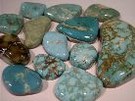 Fox is on of Nevada's most productive turquoise mines. This mine is located near Lander County and was mined during by prehistoric cultures by Native Americans. This mine was rediscovered sometime around 1911. It is said to have produced over a half million pounds of turquoise. This mine was also known at one time as the Cortez turquoise mine. In the 1940's, Dowell Ward purchased the old Cortez claims and developed them using the names Fox, White Horse, Green Tree and Smith to differentiate among the colors produced in the area and to create a larger perceived share of the turquoise market. The area produces a huge amount of good quality green or blue-green stone with a distinctive matrix.
Fox is on of Nevada's most productive turquoise mines. This mine is located near Lander County and was mined during by prehistoric cultures by Native Americans. This mine was rediscovered sometime around 1911. It is said to have produced over a half million pounds of turquoise. This mine was also known at one time as the Cortez turquoise mine. In the 1940's, Dowell Ward purchased the old Cortez claims and developed them using the names Fox, White Horse, Green Tree and Smith to differentiate among the colors produced in the area and to create a larger perceived share of the turquoise market. The area produces a huge amount of good quality green or blue-green stone with a distinctive matrix.
TURQUOISE - GODBER TURQUOISE
This is also referred to and known most often today as Dry Creek turquoise. The Dry Creek turquoise mine is located on the Shoshone Indian Reservation near Battle Mountain, Nevada. Discovered in 1993, they were not sure what it was. Because of its hardness, it was decided to send it to have it assayed and it was in fact, as thought, turquoise. It was not until 1996 that it was used in jewelry. Turquoise gets its color from the heavy metals in the ground where it forms. Dry Creek turquoise forms where there are no heavy metals present, which turns out to be a very rare occurrence. The lack of any specific color consistency makes this stone distinctive and unique from other turquoises. To date, no other vein of this turquoise has been discovered anywhere else and when this current vein runs out, that will be the last of it. Because this turquoise is as rare as the sacred buffalo, the Indians call it "Sacred Buffalo" Turquoise.
TURQUOISE - HACHITA TURQUOISE
Hachita turquoise was mined in New Mexico and has not been mined since 1905. This turquoise was mined by ancient cultures. Hachita turquoise usually runs a deep blue and is sometimes confused with Tyrone turquoise. This turquoise is rare and a true collectible addition to your turquoise jewelry collection.
TURQUOISE - INDIAN MOUNTAIN TURQUOISE
The best known of the contemporary mines was originally discovered in 1970's by a Shoshone sheepherder who stumbled upon a vein of turquoise on a hillside while tending his sheep. Eddy Mauzy and his family mined and marketed turquoise from this site to top southwest Indian artists. Jewelry featuring Indian Mountain turquoise was featured in Arizona Highways magazine in the 1970's. Indian Mountain mine is in Lander County, Nevada.
TURQUOISE - KINGMAN TURQUOISE
 The Kingman mine is located in Mohave County in western Arizona. The Kingman turquoise mine is one of the larges turquoise mines in North America and is one of the most well known turquoise mines producing an intense blue color. While not all turquoise mines produce turquoise nuggets the Kingman turquoise mine is known for producing round and with a nice matrix nugget. The copper mining in the Mineral Park Mining District around Kingman has produced a larger supply of turquoise throughout the years. This has been a popular choice in Native American jewelry.
The Kingman mine is located in Mohave County in western Arizona. The Kingman turquoise mine is one of the larges turquoise mines in North America and is one of the most well known turquoise mines producing an intense blue color. While not all turquoise mines produce turquoise nuggets the Kingman turquoise mine is known for producing round and with a nice matrix nugget. The copper mining in the Mineral Park Mining District around Kingman has produced a larger supply of turquoise throughout the years. This has been a popular choice in Native American jewelry.
TURQUOISE - LANDER BLUE TURQUOISE
Lander Blue turquoise is the foremost of collectible turquoise there is today and the most expensive per ounce. The turquoise was found along side a hillside near the Indian Creek in north-central Nevada by Rita Hapgold. The story goes that in 1973 while picnicking, Rita, her sister, Marilynn, and their two sons collected some turquoise nuggets or black rocks with blue nodules showing. Rita went on to claim this site naming it after her mother, the Mary Louise Lode Mining Claim. She then sold it to two Hank Dorian and Marvin Syme who established the Lander Blue Mining Company.
The Lander Blue mine only gave 98 pounds of turquoise which amounts to about two buckets. This is called by many a "hat mine" because a hat could cover the area in which the turquoise could be found. The turquoise is of the highest grade; known for its rich, darker blue colors and dark, black matrix often found in nodules. Because of the value of Lander Blue turquoise, many have tried to pass off turquoise with similar appearance from the Indian Mountain turquoise mine in Nevada or the Yun-GaiSi mine in China as the Lander Blue turquoise.
TURQUOISE - LONE MOUNTAIN TURQUOISE
Lone Mountain turquoise mine, located in Esmeralda County, Nevada, once produced a great variety of turquoise. Usually found in nodules and is noted for some of the finest examples of spider web turquoise as well as clear, deep-blue stones. The turquoise is also noted for its ability to hold its color and not fade. Among "classic" American turquoise, only Lander Blue is more valuable. This mine has also been known as Blue Jay Mine. Lone Mountain turquoise is a valued addition to one's jewelry collection.
TURQUOISE - MANASSA TURQUOISE
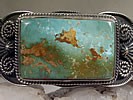
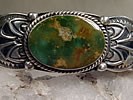 Also known as King's Manassa turquoise, Manassa turquoise mine is located in Manassa, Conejos County, Colorado. This site was originally mined by Ancestral Pueblo people and was rediscovered in 1890 by gold prospector, I.P. King. His descendants still work the claim. King's Manassa turquoise is best known for its rich, brilliant greens and golden matrix. Blue and blue-green turquoise has been found amid these deposits as well.
Also known as King's Manassa turquoise, Manassa turquoise mine is located in Manassa, Conejos County, Colorado. This site was originally mined by Ancestral Pueblo people and was rediscovered in 1890 by gold prospector, I.P. King. His descendants still work the claim. King's Manassa turquoise is best known for its rich, brilliant greens and golden matrix. Blue and blue-green turquoise has been found amid these deposits as well.
TURQUOISE - MORENCI TURQUOISE
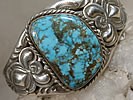
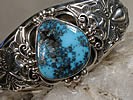 Morenci turquoise is mined in southeastern Arizona, Greenlee County. It is high to light blue in color with an unusual matrix of irregular iron pyrite or "fool's gold"matrix that when polished often looks like silver. The name is derived from the large open pit Morenci copper mine where a great deal of turquoise from Morenci has been of the "lunch box" variety - carried out by workers and miners. Morenci turquoise is well known; it was one of the first American turquoises to come on the market and is often difficult to obtain because the mine is now depleted. Morenci turquoise is a collectible.
Morenci turquoise is mined in southeastern Arizona, Greenlee County. It is high to light blue in color with an unusual matrix of irregular iron pyrite or "fool's gold"matrix that when polished often looks like silver. The name is derived from the large open pit Morenci copper mine where a great deal of turquoise from Morenci has been of the "lunch box" variety - carried out by workers and miners. Morenci turquoise is well known; it was one of the first American turquoises to come on the market and is often difficult to obtain because the mine is now depleted. Morenci turquoise is a collectible.
TURQUOISE - NUMBER 8 TURQUOISE
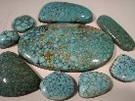 The Number 8 turquoise mine is in Calin, Nevada, and was at one time a gold and copper mining operation on the west side of the Tuscarora Mountain Range. It was a large mining district encompassing ten 20-acre claims and was active from the 1930's through the early 1950's. The mine has produced one of the most prized spider web turquoise deposits in the world. In its prime, enormous nodules were found, including one that weighed 150 pounds. Number 8 turquoise is famous for its black, golden-red and brown spider web matrix set off with the unique bright powder blue turquoise background. The mine is now depleted and Number 8 turquoise is extremely valuable.
The Number 8 turquoise mine is in Calin, Nevada, and was at one time a gold and copper mining operation on the west side of the Tuscarora Mountain Range. It was a large mining district encompassing ten 20-acre claims and was active from the 1930's through the early 1950's. The mine has produced one of the most prized spider web turquoise deposits in the world. In its prime, enormous nodules were found, including one that weighed 150 pounds. Number 8 turquoise is famous for its black, golden-red and brown spider web matrix set off with the unique bright powder blue turquoise background. The mine is now depleted and Number 8 turquoise is extremely valuable.
TURQUOISE - ORVIL JACK TURQUOISE
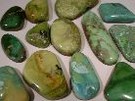 Orvil Jack discovered and developed the mine in northern Nevada that bears his name. The area where the mine is located is called the Blue Ridge in Crescent Valley. Mr. Jack is now deceased, but his daughter continues to operate the mine. The rare yellow-green color of the turquoise comes from the zinc content. This mine produces a unique color of turquoise. Only a small amount is now being produced and the turquoise is considered very collectible due to its rare color and scarcity.
Orvil Jack discovered and developed the mine in northern Nevada that bears his name. The area where the mine is located is called the Blue Ridge in Crescent Valley. Mr. Jack is now deceased, but his daughter continues to operate the mine. The rare yellow-green color of the turquoise comes from the zinc content. This mine produces a unique color of turquoise. Only a small amount is now being produced and the turquoise is considered very collectible due to its rare color and scarcity.
TURQUOISE - PILOT MOUNTAIN TURQUOISE
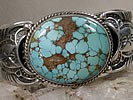
 Pilot Mountain is located in Esmeralda County, Nevada. This mine is currently active and is worked by one family. Pilot Mountain turquoise ranges in color from blue to green with a dark brown, black or reddish matrix. This stone is admired for its deep blue-green colors.
Pilot Mountain is located in Esmeralda County, Nevada. This mine is currently active and is worked by one family. Pilot Mountain turquoise ranges in color from blue to green with a dark brown, black or reddish matrix. This stone is admired for its deep blue-green colors.
TURQUOISE - RED MOUNTAIN TURQUOISE
Red Mountain is located in Lander County, Nevada. This mine has produced a large quantity of graded turquoise and the best Red Mountain turquoise rivals some of the high quality turquoise produced by the best mines in the Southwest. Red Mountain turquoise with its intricate often red spider web matrix is usually set in the finest gold and silver American Indian jewelry.
TURQUOISE - ROYSTON TURQUOISE
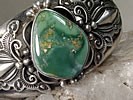 Royston is a district in Nevada consisting of three mines: Bunker Hill, Oscar Wehrend and the main producer, Royal Blue. Royston turquoise is known for its beautiful colors ranging from deep forest green to rich, light blues set off by a heavy, brown matrix. The Royston district is still producing some turquoise of high quality but in limited amounts.
Royston is a district in Nevada consisting of three mines: Bunker Hill, Oscar Wehrend and the main producer, Royal Blue. Royston turquoise is known for its beautiful colors ranging from deep forest green to rich, light blues set off by a heavy, brown matrix. The Royston district is still producing some turquoise of high quality but in limited amounts.
TURQUOISE - SLEEPING BEAUTY TURQUOISE
The Sleeping Beauty mine, one of the largest producing mines, located near Globe, Arizona, and produces a solid, light blue to robin's egg blue color with usually no matrix and is set in many styles of American Indian jewelry. The turquoise is famed for its solid blue color that rivals that of Persian turquoise. An open pit mine and a favorite of Zuni silversmiths, Sleeping Beauty is often used in needlepoint, petite point and inlay jewelry because of its consistency in color and is easy to cut. This mine is one of the largest in North America and is relatively abundant and affordable. There are many smaller and privately owned mines in this area also. Note: As of 2012 this mine has been closed due to copper mining and the cost of Sleeping Beauty turquoise still available has gone up substantially.
TURQUOISE - STORMY MOUNTAIN TURQUOISE
Stormy Mountain turquoise mine is located in Elko County, northeastern Nevada. Along with Blue Diamond mine, Stormy Mountain is known for producing hard, dark blue turquoise that includes a blotchy, black chart matrix that resembles storm clouds. This mine is presently not active and is a valuable addition to one's collection.
TURQUOISE - TURQUOISE MOUNTAIN & "BIRD'S EYE"
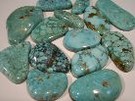 Turquoise Mountain and "Bird's eye" turquoise come from the same mine in Northwestern Arizona near the Kingman mine, Mineral Park Mining District. The mine was closed in the 1980's and has also been sold as "Old Man Turquoise." Turquoise Mountain turquoise is light to high blue with both webbed and non-webbed matrix. "Bird's eye" describes stones from this mine that show areas of light blue circled with dark blue matrix resembling the eye of a bird. It is a beautiful addition to one's collection.
Turquoise Mountain and "Bird's eye" turquoise come from the same mine in Northwestern Arizona near the Kingman mine, Mineral Park Mining District. The mine was closed in the 1980's and has also been sold as "Old Man Turquoise." Turquoise Mountain turquoise is light to high blue with both webbed and non-webbed matrix. "Bird's eye" describes stones from this mine that show areas of light blue circled with dark blue matrix resembling the eye of a bird. It is a beautiful addition to one's collection.
Shop Turquoise Mountain Jewelry
TURQUOISE - TYRONE TURQUOISE
Turquoise from the Tyrone mine was associated with the copper mine operations southwest of Silver City, New Mexico. The name "Tyrone" refers to a group of claims around Silver City and the Tyrone copper mine. This mine is currently owned by Phelps Dodge. Turquoise has not been mined from the mining operation since the early 1980's when Phelps Dodge changed its method of copper ore processing to crushing and acid wash. This method, obviously, destroys any turquoise in the copper ore. The Tyrone turquoise in new jewelry is from private stashes. It is a medium blue in its high grade form. Today, it is valued both for its beauty and rarity.
Click here to read more about Turquoise quality and grades.
